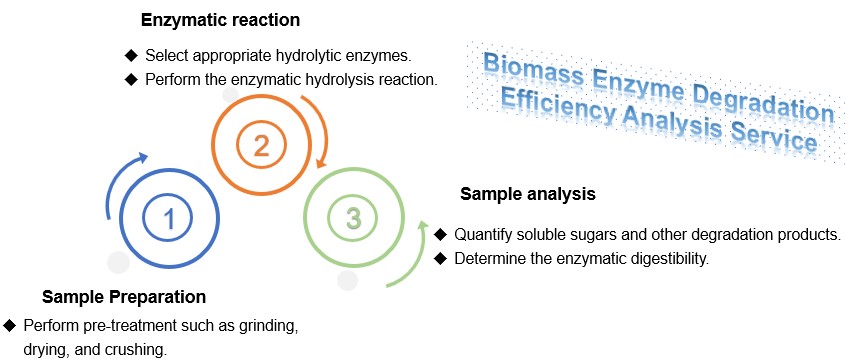Biomass Enzyme Degradation Efficiency Analysis Service
High-quality Enzyme Degradation Efficiency in Biomass at Creative Biolabs
Creative Biolabs's technical team keeps up with the latest developments in the field of biomass conversion. Our scientists have rich experience in biomass conversion and enzymatic hydrolysis, and we provide a series of Glyan-related Enzyme Activity Analysis Services, such as biomass enzyme degradation efficiency analysis, Residue Content Analysis, Saccharification Efficiency Analysis, Cellulolytic Enzyme, and Amylolytic Enzyme Activity Assessment. Among them, biomass enzymatic digestibility analysis is an experimental method used to evaluate the degree of degradation of biomass under the action of specific enzymes or enzyme systems. In this process, enzymes are often used to simulate the digestion process in organisms and evaluate the production of soluble sugars in biomass. This analysis can determine the fraction of biomass that can be degraded by specific enzymes to evaluate the degradation properties of the biomass and understand its suitability for bioconversion processes. In addition, by analyzing the enzyme digestibility of biomass, we can guide the efficient utilization of biomass resources and improve biomass conversion efficiency. Our scientists utilize advanced technology and comprehensive analysis processes to provide clients with high-quality biomass enzymatic digestibility analysis services.
Sample Preparation
We collect biomass samples such as wood fibers etc. It is then subjected to pre-treatment such as grinding, drying, and crushing to make it easier to react with enzymes.
Enzymatic reaction
We select appropriate hydrolytic enzymes according to biomass components, such as cellulase, amylase, etc. Then, the pretreated biomass sample is reacted with an appropriate hydrolase or enzyme mixture, and the enzymatic hydrolysis reaction is performed according to predetermined conditions (such as temperature, pH, etc.). The enzyme activity is then stopped by adding appropriate reagents (such as adding acid and alkali solutions or heat treatment) to end the enzymatic hydrolysis reaction.
Sample analysis
Before sample analysis, the reaction mixture is centrifuged or filtered and the supernatant phase is collected for subsequent analysis. We use chromatography (e.g., high-performance liquid chromatography) or other methods to quantify soluble products in reaction mixtures, including sugars and other degradation products. Soluble sugars measured mainly include the following types.
-
Total sugars
-
Glucose
-
Galactose
-
Mannose
-
Rhamnose
-
Xylose
-
Arabinose
-
Cellobiose
At the end of the analysis, we record and analyze the experimental data and calculate the different sugar contents in the biomass. Furthermore, we determine the enzymatic digestibility of biomass by calculating the ratio of the fraction of the biomass sample that can be degraded by enzymes to the total biomass content.

Biomass enzymatic digestibility analysis is a commonly used analysis method in the field of biomass research. Analyzing the part of biomass that can be degraded by enzymes, helps to evaluate the degradability of biomass and optimize the biomass conversion process. Moreover, this analysis can quantify the soluble sugar content and potential degradation products in biomass. These data help to further study the structure and content of biomass components. Please contact us in time if you are interested in detailed biomass analysis services.
Published data
Lignocellulosic biomass has a wide range of applications, while its internal polymer network is particularly complex, making it difficult to convert it into monomer components. Therefore, biomass must be pretreated to destroy the original structure and thereby improve the enzymatic digestibility of biomass. Using spruce wood as a starting material, the authors explored the effects of three pretreatment methods (supercritical CO2, ultrasound-assisted alkaline pretreatment, and acetyl solvent pulping for enzymatic hydrolysis) on the structure and enzymatic digestibility of spruce biomass. The results showed that enzymatic hydrolysis of spruce wood by acetyl solvent pulping improved enzymatic digestibility and produced reducing sugar yields up to ~95.0 wt%. The authors pointed out that this research could be applied to other biomass and scaled up to tap the potential of the biomass industry.
 Fig.1 Enzyme digestibility analysis process of spruce wood.1, 2
Fig.1 Enzyme digestibility analysis process of spruce wood.1, 2
FAQs
Q1: Have you conducted similar types of biomass enzymatic digestibility analysis projects before?
A1: Yes, we have extensive experience and have completed multiple similar biomass enzymatic digestibility analysis projects. We master the properties of various types of biomass and the corresponding experimental methods.
Q2: What specific enzyme species are used in your experimental method? What parameters do the enzymatic hydrolysis conditions you use include?
A2: We select appropriate enzymes such as glucosidase and cellulase for analysis according to project requirements. Regarding enzymatic hydrolysis conditions, we will consider factors such as temperature, pH value, reaction time, etc., and optimize and adjust them according to the characteristics of the biomass sample and the purpose of the experiment.
Q3: How do you verify the accuracy of the results of biomass enzymatic hydrolysis rate in your experiments?
A3: We will use internal standard materials or external reference materials for verification to ensure the accuracy of experimental results.
Customer Review
High-level Service
"Thanks to Creative Biolabs for providing biomass enzymatic digestibility analysis service! Your team is very professional and has demonstrated a high level of work performance from experimental design to data analysis. The report content is detailed and is of great significance to the advancement of our research project."
Timely Feedback
"Creative Biolabs's feedback is quick and communication is smooth, making the entire cooperation process very pleasant and efficient. Through your service, I have a new understanding of the enzymatic hydrolysis performance of biomass, which is of great significance to my academic research and project development."
References
-
Kumar, Pawan, et al. "Enzymatic digestibility of lignocellulosic wood biomass: Effect of enzyme treatment in supercritical carbon dioxide and biomass pretreatment." Heliyon 9.11 (2023).
-
Under Open Access license CC BY 4.0, without modification.
For Research Use Only.
Related Services


 Fig.1 Enzyme digestibility analysis process of spruce wood.1, 2
Fig.1 Enzyme digestibility analysis process of spruce wood.1, 2



